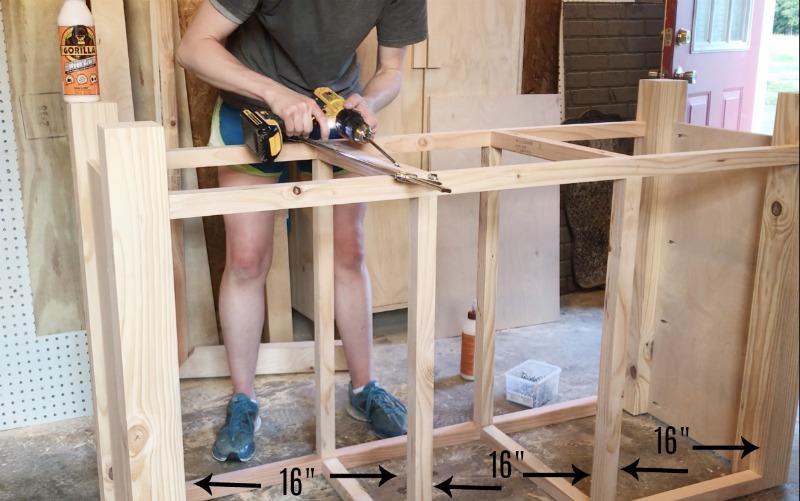Faux Drawer Bathroom Vanity
By Woodshop DiariesNon traditional bathroom vanities that look like dressers are so popular right now, but installing a sink into a cabinet full of drawers can be complicated. But with these plans, building your own faux drawer vanity is a breeze. And you don’t have to sacrifice any storage space to get the design!
Directions
-
Cut Side Panels
Using a Kreg Rip-Cut and AccuCut, rip a piece of plywood from one of your full sheets to 13” wide. Then, cut two pieces from that piece at 31” long. These will be your side panels.
-
Cut Legs for Vanity
Cut 4x4 legs according to the cut list above. Be sure to sand them well as typical 4x4 posts aren’t the smoothest pieces of lumber you can buy.
-
Assemble Side Panels
Using a Kreg Pocket Hole Jig, drill ¾” pocket holes along the long edges of the side panels and attach between the leg pieces using 1 ¼” pocket hole screws. Make sure to attach so that the top of the side panel is flush with the top of the legs (the bottom of the side panel should be 4” above the bottom of the leg) and the outside of the panels are ¾” from the outside of the legs.
-
Assemble Vanity Frame
Now it’s time to assemble the frame of the vanity. Cut your 2x2 pieces for the frame according to the cut list and drill 1 ½” pocket holes into each end of each frame piece. Then, attach like shown using 2 ½” pocket hole screws. Each section between dividers should be 16” wide. You will have four 2x2s for the top and bottom/front and back pieces, four 2x2 tall dividers, and four 2x2 short dividers. NOTE: attach the bottom 2x2s so that the bottom is 4” from the bottom of the legs. ALSO NOTE: the image below shows the vanity turned upside down for easier access to attach supports.
-
Prepare Divider Panels
Cut 2 divider panels according to the cut list. Again, it’s quick and easy to trim down large plywood sheets using a Kreg Rip Cut and AccuCut. Drill ¾” pocket holes along the edges of each piece.
-
Attach Divider Panels
Attach divider panels to frame like shown using 1 ¼” pocket hole screws. Attach so that the pocket holes face the middle and so that the panels are flush to the inside of the middle section. This helps when attaching drawer slides later so you won’t need spacers.
-
Add Bottom Panels
Cut two pieces of ¾” plywood according to the cut list for the bottoms. Once they are cut, you will need to mark where to notch two corners of each piece so they will fit around the legs. It’s best to mark to fit and trim down as needed, but they should be about 2” square notches. Carefully cut these with a jig saw. Then, drill ¾” pocket holes around the edges and attach using 1 ¼” pocket hole screws on the two outside sections like shown making sure the top is flush with the top of the frame pieces.
-
Attach Drawer Slides
Now to the fun stuff! It’s time to attach the drawer slides for the center drawers. Using a Kreg Drawer Slide Jig makes this ten times easier. Attach 3 pair of 18” drawer slides to the center section of the cabinet like shown. Attach the first one about 7” from the bottom, the bottom one about ¼” from the bottom of the frame and the middle one centered between the two.
-
Build Drawers
Cut all drawer pieces according to the cut list. It’s easiest to rip a couple strips about 8” wide off a sheet of plywood, then trim down on your miter saw to get your final pieces. Once you’ve got them cut, drill ¾” pocket holes into each end of the 13 ½” pieces. Then, if you wish to use dadoes to attach the bottoms, cut your dadoes now, before attaching. Otherwise, you can attach the bottoms using glue and brad nails after assembly. Assemble drawer boxes using 1 ¼” pocket hole screws and placing the 13 ½” pieces between the 18” pieces. Don’t forget to add your bottoms before the last side goes on if you are using dadoes. If not, glue and nail on the bottoms now.
-
Install Drawers into Vanity
Now, install your drawers onto your slides in the cabinet. The Kreg Drawer Slide Jig instructs you how to do this. But, I always attach my drawers onto my already mounted slides and adjust as needed to get them level.
-
Add Drawer Fronts
Cut drawer fronts according to the cut list. Add edge banding if desired. Glue and nail these into place on the fronts of the drawers. For extra holding power, once nailed in place, screw a few 1 ¼” screws in from the inside of the drawer to hold the drawer front. Make sure to leave ABOUT 1/8” gap around all sides of the drawer front.
-
Prepare Doors
First, cut your two doors according to the cut list. I recommend applying edge banding around the door before cutting the faux drawer lines. You can see how to use a Kreg AccuCut to cut these “faux drawer” grooves into your door on my Faux Drawer Farmhouse Dresser plan on Build Something. (Direct link in the Extras tab.) However, since I only needed to cut two grooves the same distance from the edge, I used my table saw for this. But if you don’t have a table saw, the AccuCut would work perfect for this as well. I set my blade 9 1/8” from the rip fence and only about ¼” high. I ran one side of my door through to cut one “faux drawer” line, then flipped it around and did the other side. This gave me 3 “drawers” of equal size. If using the AccuCut and circular saw, set your blade depth to ¼” and set your AccuCut to cut a line 9 1/8” from one edge. Once that’s cut, just set it up again to cut 9 1/8” from the other edge.
-
Attach Doors
Because you want this to appear to be drawers, you don’t want exposed hinges. Concealed hinges work perfect or this application and they are easy to install using a Kreg Concealed Hinge Jig. Simply use the jig to drill the holes for the concealed hinge cups, then follow the hinge instructions for installing them into your cabinet. Now it looks like your cabinet has 9 drawers…but you know the truth ;)
-
Finish
Finish the vanity as desired. I used Early American wood stain and a clear coat on top. But you could paint or stain whatever color you wish!
-
Install Hardware
The last step (before the countertops) is to install the hardware. Since I was installing 9 identical drawer pulls in the same location on each drawer, using my Kreg Cabinet Hardware Jig came in handy. Simple set it up to fit the hardware type and size you are using, then transfer to each drawer to make sure to get your screw holes in the same location each time!
-
Install the Countertop
I had my granite and sinks cut at a local granite company. I made sure to give them the measurements of my vanity they could make sure the sinks fit into the correct cabinet location. Just clear silicone and set in place. I built this for a friend, so the faucets aren’t installed here, but you get the idea, right? You could also build your own wooden top for this and install your sinks yourself if desired. Install the plumbing and the faucets and you are good to go! What’s really awesome about having cabinets under the sinks vs drawers is that this way, you don’t have to cut anything to fit around the plumbing AND you get to use all the storage space below instead of having stationary drawers where the sink goes. It’s a win –win! Check out more details on the link in the extras tab
-
Optional--Add Cabinet Backs
Since your plumbing will go through the back and into your wall, adding the cabinet back is optional. If you would like to add a back, keep in mind, you will need to cut out a hole for the plumbing when it is installed. Cut two pieces of ¼” plywood according to the cut list for the backs and simply staple in place onto the back sides of the cabinet. You can add one behind the drawers as well, but I usually don’t add a back behind drawers, only cabinets.





























